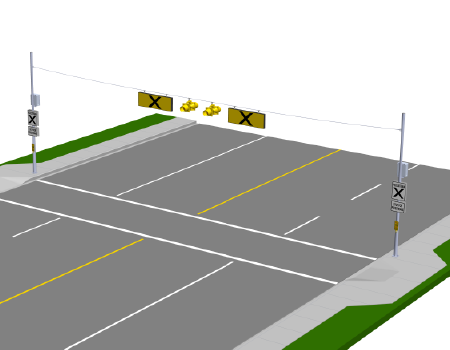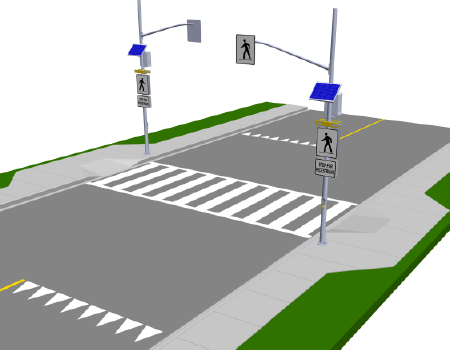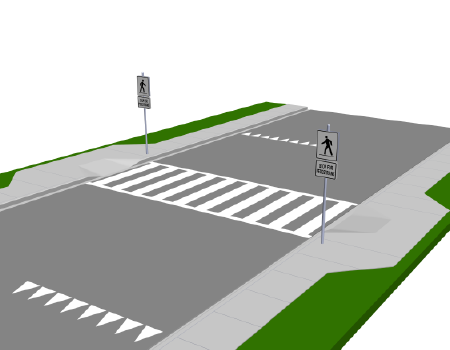OTM Book 15 crosswalk guide
In Ontario, Canada, the Ontario Traffic Manual (OTM) is the guiding document for transportation practitioners. It comprises 22 books and is continuously updated to ensure uniformity in the design, application, and operation of traffic control devices and systems across the province.
Book 15 basics
In 2016, the Ontario Ministry of Transportation unveiled Book 15, Pedestrian Crossing Treatments, which provides comprehensive guidelines for designing, implementing, and maintaining pedestrian crossings. It covers various crossing types, such as marked crosswalks and pedestrian signals, along with standards for sight distance, crossing width, signage, and more. The book also introduces new PXO layouts for low-speed, low-volume roads, offering municipalities options for non-signalized pedestrian crossings.
Carmanah’s solar and AC-powered beacons are perfect for these crossings or at existing crossings. Our systems:
- Are easy to mount or retrofit onto a range of square and round poles
- Improve driver compliance to produce the highest yield rate per dollar spent on the system
- Support passive activation sensors and audible pushbutton stations to increase user accessibility.
- Are customized using our online Solar Power Report – a solar site assessment to recommend the optimal solar-powered beacons to meet project requirements
- Are customized using our online Build Tool to configure a product with desired options and solar sizing. The results are saved into a data sheet that can be downloaded and shared with colleagues easily.
- Solar-powered systems are free from trenching, cabling, and in-ground wiring
With our MX Series of connected traffic beacon and sign systems, agencies can add connectivity to their infrastructure simply and affordably. Why choose MX?
- Modular design makes for faster installation and better, richer system data
- Every system ships with 3 years of free connectivity
- Connectivity is embedded at the factory and operational from the moment it receives power. The system is “online” and accessible locally via the free MX Field App™ and remotely via our web-based software, MX Cloud™. Learn more about MX Cloud subscriptions
- Use remote connectivity for scheduling, system monitoring, and reporting
- Actionable email and text alerts are sent the minute there is an issue, such as a knockdown or dead battery
- View dispersed assets in a single centralized location. Adjust settings like flash duration and night dimming and download data like activation counts.
Pedestrian crossovers
Pedestrian crossovers are marked crosswalks identified by signs and pavement markings. Pedestrians, vehicles, and cyclists must all understand the road rules at these crosswalks to ensure safety for everyone.
Pedestrians must exercise due care and cross only when traffic has come to a complete stop. If the PXO has a flashing beacon, the corresponding button should be pressed to activate it; the beacon will help increase driver awareness.
Vehicles must watch for pedestrians, be prepared to stop, and only start moving again once the pedestrian has cleared the roadway.
Cyclists must follow the same rules as vehicles. Cyclists wishing to cross at the PXO should dismount and walk the bike across.
Types of PXOs
There are four different types of PXOs. Learn about the requirements, applications, and Carmanah flashing beacon solutions available for each one. The Ontario Traffic Manual Book 15 document contains the complete configuration requirements for each.
PXO – Level 1: Type A

What they are: Level 1 Type A pedestrian crossovers include the use of regulatory signs, flashing circular amber LED beacons, internally illuminated signs, and “X” pavement markings. The circular LEDs and internally illuminated signs are mounted overhead on a span wire. Two circular LEDs are required to face each direction of traffic.
Where to use them: Midblock and at uncontrolled intersections.
Suitable Carmanah solutions: R920-MX, R820 series
PXO – Level 2: Type B

What they are: Level 2 Type B pedestrian crossovers include the use of regulatory signs, rectangular rapid flashing beacons (RRFBs), and pavement markings. This configuration uses side-mounted RRFBs, along with side-mounted and overhead-mounted regulatory signs.
Where to use them: Mid-block crosswalks, uncontrolled intersections, single-lane roundabouts, and double-lane roundabouts.
Suitable Carmanah solutions: R920-MX, R920-E, R920-F, SC315-G
PXO – Level 2: Type C

What they are: Level 2 Type C pedestrian crossovers include the use of regulatory signs, warning signs, and pavement markings. This type of pedestrian crossover only uses side-mounted regulatory signs and rectangular rapid flashing beacons (RRFBs).
Where to use them: Mid-block crosswalks (with or without a raised refuge), uncontrolled intersections (with or without a raised refuge), single-lane roundabouts, and double-lane roundabouts.
Suitable Carmanah solutions: R920-E, R920-F, SC315-G
PXO – Level 2: Type D

What they are: Level 2 Type D pedestrian crossovers include the use of regulatory signs, warning signs, and pavement markings. This type of pedestrian crossover uses only side-mounted regulatory signs; flashing beacons are not required for this type of crossover.
Where to use them: Mid-block crosswalks (with or without a raised refuge), uncontrolled intersections (with or without a raised refuge), single-lane roundabouts, double-lane roundabouts, and right-turn channelization.
Suitable Carmanah solutions: No beacons required.
Upgrades & optional add-ons
Tailor your PXO with additional products that improve pedestrian safety specific to your site.
Overhead Lighting
While many mid-block crosswalks are in locations with traditional street lighting, it’s typically not enough to adequately illuminate a pedestrian or light the entire crosswalk area. Read this case study on how RRFBs and overhead lighting bring increased visibility and safety to Port Hope, Ontario.
ADA, PROWAG, and MUTCD Compliant Pedestrian Activation
Enhance usability with pushbuttons and activation methods compliant with ADA, PROWAG, and MUTCD standards and guidelines.

Standard push button

APS pushbutton

APS push button with non-contact operation

Microwave-based passive activation sensor
Get started with a PXO
Has your Ontario city recently approved a PXO in a new location, or are you upgrading an existing location? We have a downloadable, printable version of this information to share with your team. Check our support page—it’s bursting with FAQs, articles, and links to helpful articles. Want to request a Solar Power Report? Click here. Ready to build your custom product and download a customized data sheet? Click here.
Fill out the form below to download the guide:
